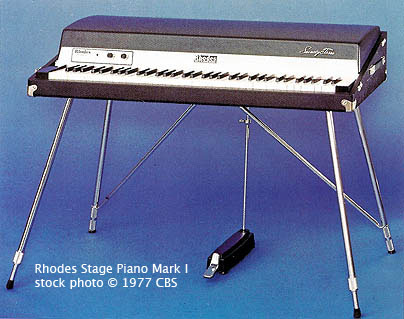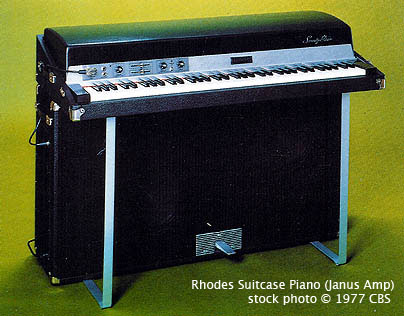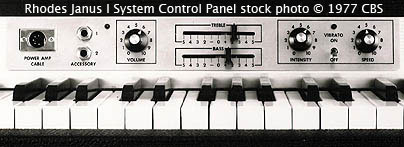Rhodes Mark I (1975-1979)
Sometime in 1974, CBS Musical Instruments decided to drop the Fender name from the Rhodes line of products, in order to establish Rhodes as its own brand. This allowed music stores that were not Fender dealers to carry Rhodes pianos, without an obligation to stock other CBS products. As was common throughout the piano's production history, the new "Rhodes" logos and serial plates were introduced as they became available to the factory, making the official transition date difficult to pinpoint. Aside from the branding, nothing really changed about the piano's construction during 1975.

Throughout the late 70's the Rhodes Mark I Stage Piano and Suitcase Piano continued to be produced in 73- and 88-key configurations, with the Suitcase Piano continuing to use the FR7054 80W Peterson amplifier until 1977. The Piano Bass was still available during this time, though it did not sell nearly as well as the Suitcase and Stage models. As in previous generations, the Piano Bass shared the same appearance and internal components as the full-size pianos.
Design changes began in 1976, with the first being molded all-plastic hammers to replace the half-wood/half-plastic style that had been used since the teardrop hammers were phased out around 1970. The Neoprene hammer tips were replaceable as in the previous generation, but the underside of the hammer cam was completely flat (not curved) and the felt that was normally glued to the key pedestal was placed on the hammer itself. The resulting action was not ideal, and a second generation of plastic hammer combs with the original curved cams and pedestal felts was quickly phased in by 1977. It is unclear whether the 1976 pianos have a higher incidence of tine breakage (i.e. snapping in half with a single strike vs. the "deadening" of tone that typically occurred in Torrington tines over years of use), but this has been a recurring complaint in recent years. It may have been due to a bad generation of tines delivered to the factory, an artifact of the poorly-designed action, or both.
With the new plastic hammers in 1977 came the return of the key pedestal "bump", which was originally found in the Sparkletop teardrop action from the late 1960's. Additionally, a procedure known as the Key Pedestal Modification was later documented by CBS as it became standard in new pianos. Specifically, the pedestal felt was glued on the pedestal block, with a small "bump" of felt added beneath the main felt strip at the point where the hammer cam and the block touched when the key was at rest. The 1979 Service Manual recommended the modification for all pianos with the flat key pedestal, including the 1976 version. The "bump" would ultimately be an integrated part of the plastic-key molds used in the 1981 Mark II models, as well as the wood-key design in the Mark V.
New tines introduced in 1978 featured a "swaged" design, tapered in a way that made them 4 times more durable compared with the previous Torringon design. The combination of these tines (which may have been manufactured by Singer) and the lighter plastic action arguably produced the more stable, less bell-like sound heard on most Rhodes recordings from the late 70's.
EQ: Mellow (MP3, 219K) - Normal (MP3, 618K) - Bright (MP3, 524K)
performed by Piotr Cieslik


Of the changes during this period, the enhancements to the Suitcase Piano's amplifier are also noteworthy. The new FR7710 amp was now 100W stereo (2 x 50W), with pairs of 1/4" inputs and outputs for running the piano's signal to and from a mixing console. This made it unnecessary to mic the Rhodes amp in a live performance situation. The FR7710 amp was also packaged as a standalone upright cabinet known as the Janus I System. These amps could be used as an upgrade for the Stage Piano (replacing the previous Super Satellite system), or to triple the Suitcase Piano's output by sending the Preamp Output channels to a pair of Janus cabinets(!) for an effective 300W RMS.
On the front panel, the concentric knobs were abandoned in favor of a pair of sliders for EQ and individual knobs to control the rate (Speed) and depth (Intensity) of the Vibrato effect. The 1/4" Accessory jacks functioned as a send (#1) and return (#2) for an effects loop.
